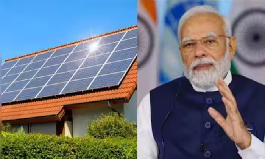The PM Surya Ghar Muft Bijli Yojana (PM-SGMBY) is expected to create a massive Rs 1.2 trillion opportunity in India’s solar power sector, according to a report by SBI Capital Markets. The report noted that this scheme, which focuses on promoting residential rooftop solar installations, aims to achieve an ambitious target of 30 GW capacity. It offers a substantial capital cost subsidy, significantly reducing payback periods by 4-5 years and encouraging greater adoption of solar energy.
It said “The scheme possesses the potential to catalyze a Rs. 1.2 trn ecosystem, with manufacturers of essential components, including modules, inverters, mounting equipment, and electrical components, anticipated to be primary beneficiaries alongside project developers and EPC players”.
The scheme is also advantageous for project developers and EPC players, who are leveraging the capex model, where customers finance and own the installations, to take advantage of subsidies. The report also added that residential rooftop installations are expected to outpace other segments due to strong policy support, particularly in states with high residential electricity tariffs and favourable net metering policies.
Non-utility solar segments, including residential and commercial and industrial (C&I), are also gaining momentum, driven by declining costs of modules and EPC services. With cheaper solar cells expanding off-grid opportunities, the annual addition of non-utility solar installations is projected to reach around 20 GW by FY27.
Currently, five states account for 70 per cent of India’s solar rooftop capacity. Gujarat leads with 4,822 MW, followed by Maharashtra (2,847 MW), Rajasthan (1,415 MW), Kerala (966 MW), and Tamil Nadu (876 MW). The growth of solar adoption is linked to factors such as industrialization, tariff differences, state-level incentives, and metering policies. As residential installations rise, the report highlighted that PM-SGMBY is poised to play an important role in democratizing green energy and boosting India’s renewable energy goals.



